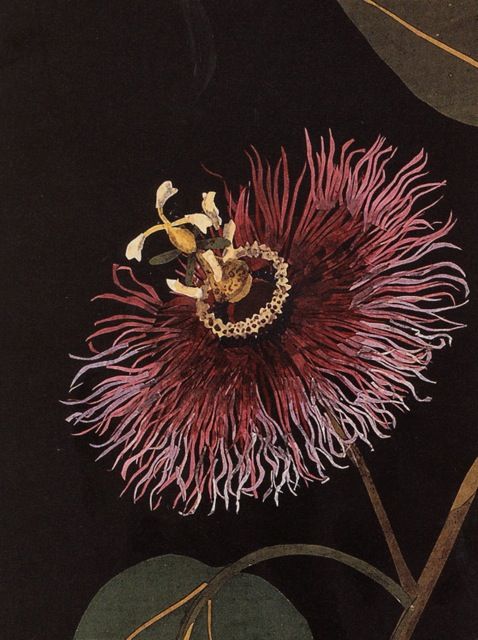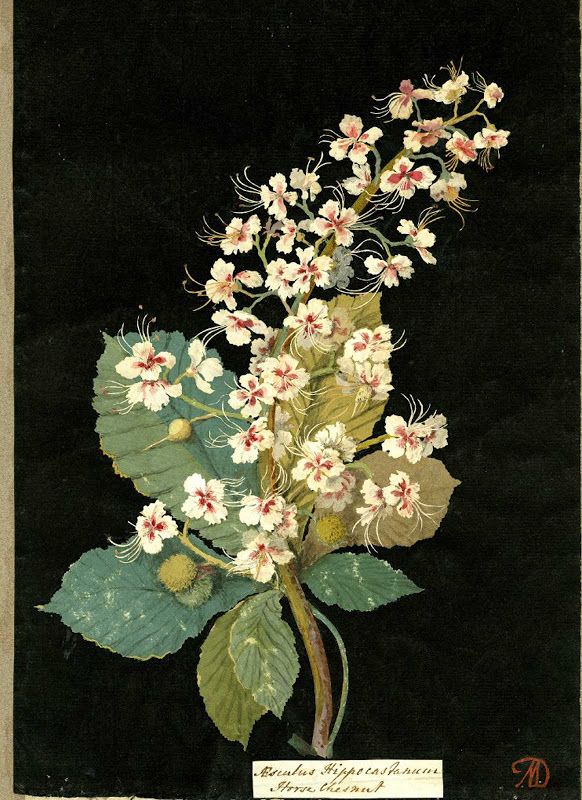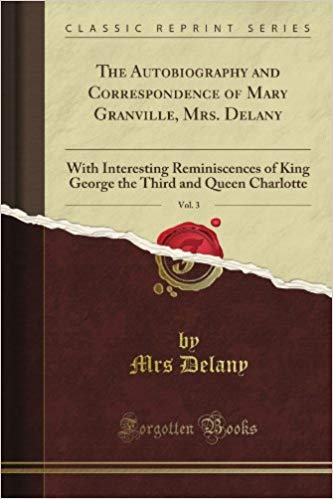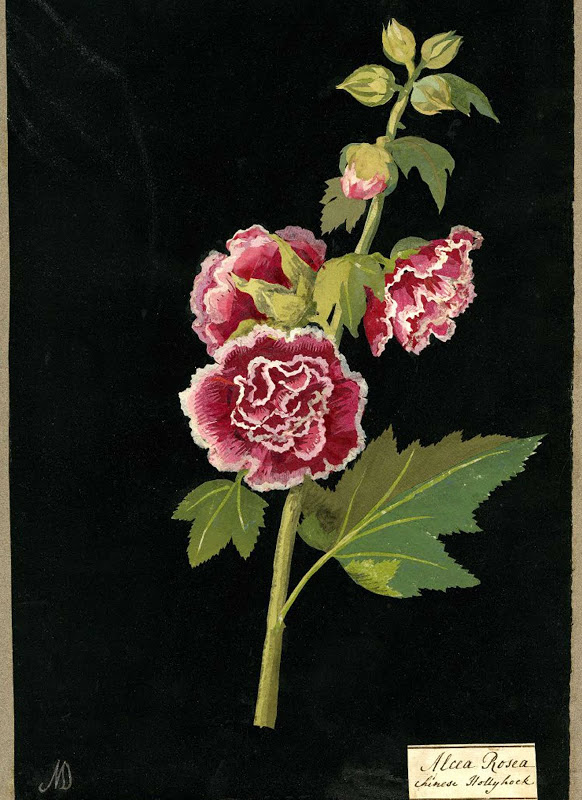
A few years ago I had the opportunity to visit an exhibition called “Mrs. Delany and Her Circle,” at the Yale Center for British Art. The show, organized by the Center for British Art and Sir John Soane’s Museum in London, included work in every conceivable medium.

One of the items included in the exhibition was the needlework Mrs. Delany executed on a black ground for the court dress mentioned in a previous post and shown here.
The piece of fabric was placed between two panes of glass, allowing visitors to examine it closely. I have been doing crewel, embroidery and needlepoint for decades and must say that I’ve never seen anything so astonishing. Mrs. Delany’s stitches were neat and well placed, but that was only the beginning. The reverse of the fabric had been as neatly wrought as the front, with nary a knot in sight. The threads were as vibrantly coloured today as they must have been two hundred years ago, showing the detail of the design and the subtlety of color variations throughout the work. It is astonishing to realize that the designs for Mrs. Delany’s work originated in her own mind. Perhaps she worked her pieces directly from that picture in her mind’s eye. However, she was also able to translate those designs onto other pieces of fabrics and to write instructions and colour directions down, thus making needlework “kits” for her friends and family to execute.


In 1861, Augusta Hall (Baroness Llanover) edited a volume called The Autobiography and Correspondence of Mary Granville, Mrs. Delany. In the appendix, the editor wrote:
“Were it possible to give a list of the work designed and executed by Mrs. Delany with the needle, independent of the quantity of various works in various ways designed by her for her friends to execute, it would be a much more extraordinary exemplification of what may be achieved by human industry and ingenuity, aided by natural talent, than the catalogue of her paintings. The Editor is not able to give an account of more than the specimens of Mrs. Delany’s needlework which are in her own possession, and that of her sister, and a few other relations. Of these are a number of chairs, the backs and seats of which are embroidered in a manner entirely different to anything that has ever (in the knowledge of the Editor) been done for a similar purpose. They consist of magnificent groups of flowers from nature, some on light and some on dark grounds, all different from each other, and all executed in worsted chenille, (made upon linen thread;) possessing the finest semi-tones of colour, which produce a variety of tint and harmony, as well as depth of colour, which never appear in the modern dyes of wool of any description. Some of these chairs are worked in embroidery stitch upon canvas, by which means the utmost freedom of outline was possible, and the most exact imitation of nature. In other sets of chairs cloth was used as the ground upon which the outline of the flowers must have been sketched, and the shades and colours filled in by sewing down the worsted chenilles by the eye, and cutting them off where required. These specimens prove Mrs. Delany’s marvellous talent for design, as well as ability in execution, and are suitable for furniture which though ornamental was yet useful; but there also exist bed hangings, and chair and sofa covers, which combine in as remarkable a manner striking effect with every day utility. Some of these were the covers of her drawing-room chairs in London, where the ground was brilliant dark blue linen, bordered with leaves cut out by herself in white linen, and edged and veined with white knotting of different sorts and thickness, sewed down along the edge. A bed completed by herself, and her sister Ann Granville, was of nankeen, with designs executed in white linen, for the headboard and hangings, all different, but well adapted to the various parts, and of a washing material, the durability of which as well as the excellence of the work is best proved by its endurance for near a hundred years in continual use! Mrs. Delany did not employ silk for her furniture, but woollen or linen materials; and the worsted chenilles, made on linen thread, never were attacked by the moths: there is now a box of them in the Editor’s possession left from Mrs. Delany’s work, which are still fit for use; it ought also to be mentioned that all these chenilles were wound on two cards folded together by herself in a peculiar manner, which prevented the chenilles being cut by the edges of the cards.”

Mrs. Delany died April 10th, 1788, and was interred in a vault belonging to St. James’ church, where a monument has been erected to her memory.
For further reading on Mrs. Delany read Mrs. Delany: Her Life and Her Flowers by Ruth Hayden (ISBN: 071418022X / 0-7141-8022-X ); Mrs. Delany (Mary Granville): A Memoir, 1700-1788 by George Paston (ISBN: 1150362642 ) and The Autobiography and Correspondence of Mary Granville, Mrs. Delany by Augusta Hall (Baroness Llanover).

What exquisite work. I would love to be able to examine it up close. Until I started writing full-time I spent quite a bit of my time on needlework, but I have never had the sort of skill it takes to render a piece the same on either side. The patience and skill required to do so boggles the mind.